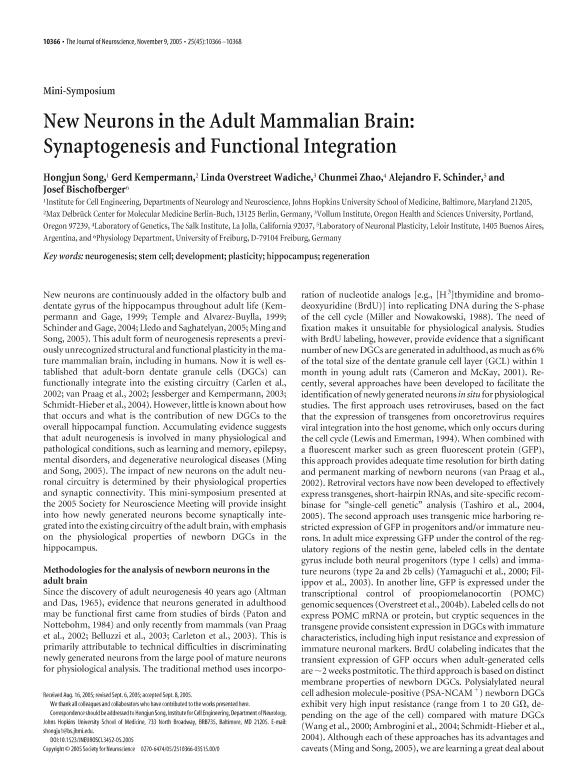Mostrar el registro sencillo del ítem
dc.contributor.author
Song, Hongjun
dc.contributor.author
Kempermann, Gerd
dc.contributor.author
Overstreet Wadiche, Linda
dc.contributor.author
Zhao, Chunmei
dc.contributor.author
Schinder, Alejandro Fabián

dc.contributor.author
Bischofberger, Josef
dc.date.available
2018-04-19T18:08:49Z
dc.date.issued
2005-11
dc.identifier.citation
Song, Hongjun; Kempermann, Gerd; Overstreet Wadiche, Linda; Zhao, Chunmei; Schinder, Alejandro Fabián; et al.; New Neurons in the Adult Mammalian Brain: Synaptogenesis and Functional Integration; Society for Neuroscience; Journal of Neuroscience; 25; 45; 11-2005; 10366-10368
dc.identifier.issn
0270-6474
dc.identifier.uri
http://hdl.handle.net/11336/42703
dc.description.abstract
New neurons are continuously added in the olfactory bulb and dentate gyrus of the hippocampus throughout adult life (Kem- permann and Gage, 1999; Temple and Alvarez-Buylla, 1999; Schinder and Gage, 2004; Lledo and Saghatelyan, 2005; Ming and Song, 2005). This adult form of neurogenesis represents a previ- ously unrecognized structural and functional plasticity in the ma- ture mammalian brain, including in humans. Now it is well es- tablished that adult-born dentate granule cells (DGCs) can functionally integrate into the existing circuitry (Carlen et al., 2002; van Praag et al., 2002; Jessberger and Kempermann, 2003; Schmidt-Hieber et al., 2004). However, little is known about how that occurs and what is the contribution of new DGCs to the overall hippocampal function. Accumulating evidence suggests that adult neurogenesis is involved in many physiological and pathological conditions, such as learning and memory, epilepsy, mental disorders, and degenerative neurological diseases (Ming and Song, 2005). The impact of new neurons on the adult neu- ronal circuitry is determined by their physiological properties and synaptic connectivity. This mini-symposium presented at the 2005 Society for Neuroscience Meeting will provide insight into how newly generated neurons become synaptically inte- grated into the existing circuitry of the adult brain, with emphasis on the physiological properties of newborn DGCs in the hippocampus.
dc.format
application/pdf
dc.language.iso
eng
dc.publisher
Society for Neuroscience

dc.rights
info:eu-repo/semantics/openAccess
dc.rights.uri
https://creativecommons.org/licenses/by-nc-sa/2.5/ar/
dc.subject
Neurons
dc.subject
Brain
dc.subject
Synaptogenesis
dc.title
New Neurons in the Adult Mammalian Brain: Synaptogenesis and Functional Integration
dc.type
info:eu-repo/semantics/article
dc.type
info:ar-repo/semantics/artículo
dc.type
info:eu-repo/semantics/publishedVersion
dc.date.updated
2018-04-05T19:23:00Z
dc.identifier.eissn
1529-2401
dc.journal.volume
25
dc.journal.number
45
dc.journal.pagination
10366-10368
dc.journal.pais
Estados Unidos

dc.journal.ciudad
Washington
dc.description.fil
Fil: Song, Hongjun. University Johns Hopkins; Estados Unidos
dc.description.fil
Fil: Kempermann, Gerd. Max Delbrück Center for Molecular Medicine Berlin Buch; Alemania
dc.description.fil
Fil: Overstreet Wadiche, Linda. University of Oregon; Estados Unidos
dc.description.fil
Fil: Zhao, Chunmei. Salk Institute for Biological Studies; Estados Unidos
dc.description.fil
Fil: Schinder, Alejandro Fabián. Consejo Nacional de Investigaciones Científicas y Técnicas. Oficina de Coordinación Administrativa Parque Centenario. Instituto de Investigaciones Bioquímicas de Buenos Aires. Fundación Instituto Leloir. Instituto de Investigaciones Bioquímicas de Buenos Aires; Argentina
dc.description.fil
Fil: Bischofberger, Josef. University of Freiburg; Alemania
dc.journal.title
Journal of Neuroscience

dc.relation.alternativeid
info:eu-repo/semantics/altIdentifier/url/http://www.jneurosci.org/content/25/45/10366.long
dc.relation.alternativeid
info:eu-repo/semantics/altIdentifier/doi/http://dx.doi.org/10.1523/JNEUROSCI.3452-05.2005
Archivos asociados
